Changes in Medieval Commerce and Production
The following represent some of the important economic changes that took place in Medieval civilization, especially in the High Medieval period (10th-14th centuries):
I. Monastic Time and Corporation Law
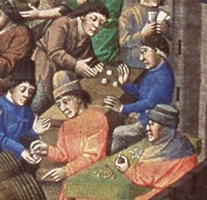
A. Time Consciousness
Monastic communities that followed the Benedictine rule prayed six to eight times a day, depending on the system. This lead to an overarching theological and temporal mentality of omnia horis competetibus compleantur ("all things in their proper time"). Because the system of prayers included night prayers and a more exacting sense of the hours of the day, the need for punctuality and time-consciousness eventually lead to the regular use of time pieces, then clocks. Along with ordering prayer, this approach with a stress on hard work and avoiding idleness also gave a new meaning to the importance of ordered work. In the 10th and 11th centuries, this monastic stress carried over into town and commercial life.
B. Incorporation
Medieval ecclesiastical, or canon, law refined early on the notion of the corporation (Lt. universitas, corpus, or collegium) as a distinct entity from the state or the family. A corporation was a social and legal entity that could both act and limit actions and that had a limited decision making ability regarding its members and property. Such ideas became settled law by the 13th century and would influence all later business models concerning economic models of business cooperation.
II. Burghs, Towns, and Trade
A. Growth of Commercial Districts
While the old administrative centers of the Western Roman Empire continued to form the nucleus of urban existence, they mostly existed as small towns attached to cathedrals. In the 10th and 11th centuries, as trade began to expand between the West and the Byzantium and the Islamic worlds and new wealth poured in, true cities began to arise. Attached to these cities were the burghs or commercial districts, whose class of people eventually was called bourgeoisie. Important trade cities included Venice, Genoa, Pisa, Milan, Florence, Flanders, and Ypres. Important goods included wool, salt, timber, beer and wine. At the same time, trade with the East was mostly in imports since these regions had their own native agricultural classes. The real impact of the new trade routes were to increase trade across Europe.
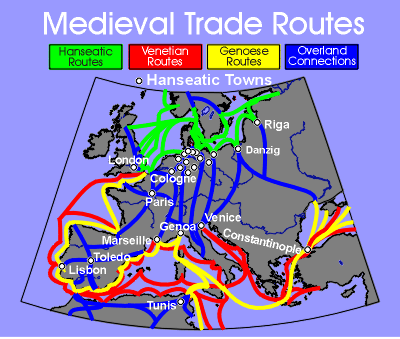
B. Town charters & Urban leagues
In the 12th century and following, towns often organized to force aristocratic lords to grant charters that guaranteed a district's property rights, taxation and toll controls, local legal codes and judicial courts, as well as limited political rule. These were not true democracies in any sense of the word, since they tended to be headed by networks of wealthy merchants, yet they were steps toward local control that helped promote a healthy economy.
Some towns began to form leagues to suppress piracy, police roads, or raise armies to oppose predatory rulers and aristocrats. Some eventually formed their own political leagues. The Hanse is a good example. A federation of German towns, they controlled the North and Baltic Sea regions until 1300.
III. Guilds, Banks, and Lenders
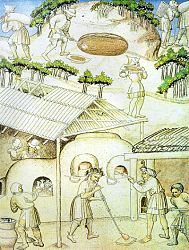 A. Guilds
A. Guilds
Merchant and craft guilds arose for similar reasons though with differing structures. Merchants formed guilds as economic negotiating blocks to force concessions from local leaders for tariff controls or safe-passage agreements. Craft guilds, on the other hand, established a system of apprentices, journeymen, and masters as a way of both learning a trade and controlling the product. Guilds developed systems of "law merchants" to handle matters of moneychanging, credit and debt, bankruptcy, billing and invoicing, and contracts. Craft masters often met together to set prices and discuss market needs, as well as enforce standards of quality. Many journeymen never reached master-status, and increasingly, masters maintained quasi-monopolies, not allowing others to set up shop.
Merchants also found ways to organize labor. They set up "putting out" systems in which an agent would contract with a large number of producers, purchasing raw materials, such as wool, then having garments stitched by other rural families in order to then take the finished product to far away markets. Eventually merchants also pioneered proto-factory production sites, locating all the materials and work needed at one site. This trend was heavily resisted by the craft gilds, though eventually over the centuries it won out.
B. Usury, Credit, Banking
For much of the early and middle medieval period loans, especially loans with interest, were considered "usury" by church and society, and such loans were either considered immoral, or at least suspect. As a result, Christians could not engage in the practice, which left it open for Jewish families. Jews were considered and treated as second-class citizens, but Jewish lenders and merchants were prosperous and generally protected by royal and papal forces until the 14th century when Italian credit replaced the earlier Jewish families; kingdoms, then, began to expel them and/or gather them into ghettos. Changes in canon law made Christian credit and interest possible. This was in part due to the Crusades of the 13th century. The need to transfer quickly large sums of money to finance the long-distance wars lead to new methods of checking and accounting, as well as making credit more respectable. Florence eventually became the largest European center of banking. By the 1320's, the Bardi and Peruzzi families became the largest banking families with branches as far away as England.
IV. Luxury and Gentility in the Aristocracy
A. New Noble Relations
With the new money economy, rulers could now obtain at times paid staff or mercenaries to populate their armies as opposed to their former dependence upon noble gifts and military support, though these traditional relationships continued for several more centuries in most places. Likewise, the distinction between nights and nobility began to blur, so that knights were increasingly wealthy, and nobles were willing to be considered knights.
B. New Trade Goods
With the growth in trade, the wealthy were now able to obtain new spices for their kitchen staff (e.g. pepper, cinnamon, ginger), new items for their homes (carpets, tapestries, costlier furniture), and better clothing and jewelry. The quality of castle quarters improved, and with the new luxuries, a more courtly gentility arose among the upper-classes. Recreations, such as hunting, falconry, and maying became popular. Kings often became indebted due to such luxuries, but they also commonly defaulted on their loans, dissolving banking families as a result.
V. Changes to Family Life
One should keep in mind that the mostly 20th century division of public work and private family life into two separate spaces is a modern invention and one that medieval people would not have recognized at any level of society, from aristocrats to the peasantry. This meant that as changes to labor and trade took place, they tended to be picked up by all members of the family. Women in trade homes often learned the craft or the family business along with the men in the household, and in times of duress wives might be called on to manage the family business, though they typically could not assign themselves to guilds or own property.
Chimneys lead to improved heat regulation and cleaner homes for the better off; this in turn, lead to the rise of private quarters for members of the family, as well as the servants. Before this change, aristocratic families tended to live in close proximity to their servants and livestock.
Improved diet and health also resulted from the growth and prosperity. In particular, more protein and iron, from peas, beans, eggs, fish, and cheese. This increased the overall population, especially women, placing pressure on existing economic systems.
VI. Changes to Agriculture and Peasant Life
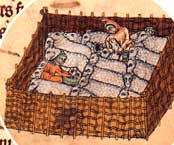 Technologies arose after the year 1000 that improved agricultural yield. A heavier metal plow made possible deeper furrows for better irrigation; windmills improved and sped up the processing of grain; the horse collar replaced the yoke, allowing for better and longer work by animals; the axle on wagons improved foodstuff transportation.
Technologies arose after the year 1000 that improved agricultural yield. A heavier metal plow made possible deeper furrows for better irrigation; windmills improved and sped up the processing of grain; the horse collar replaced the yoke, allowing for better and longer work by animals; the axle on wagons improved foodstuff transportation.
About this time as well, the three-field system of crop rotation replaced the two-field system, allowing a field to be fallow every third year, thus improving overall soil fertility. This often resulted in surplus crops.
As trade increased and a money-based economy became more wide-spread, specialization in certain crops became possible. While certainly the majority of farming was still far-removed from the large single cash crops of 20th century agriculture, a system began to develop where certain regions in Europe were noted for their wool, wine, or lumber.
B. New Social Systems
Likewise, large forests that acted as boundaries between villages began to disappear as more clearing of fields and establishment of new villages was undertaken. This lead to the waning of serf systems, as villages became more informed about the life of nearby communities that has previously been separated. With agricultural growth, serfs were motivated to produce beyond the amount owed their landlord and thus increase their own standing wealth. Yet at the same time, lords began employing landless laborers who had less negotiating power than serfs. Taxation also increased on the grinding of grain and the transportation of it to markets.
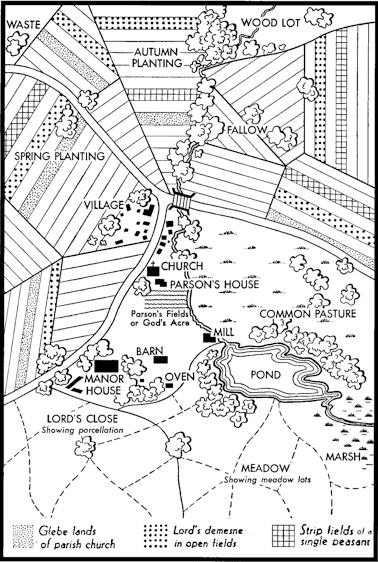
Additional primary sources on economic life can be found at Medieval Source Book.
